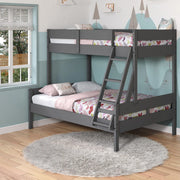
Sharing a room with a sibling can be both a challenge and an opportunity to create a special bond. It's important to design a space that respects each child’s individuality while fostering a sense of unity. Creating distinct areas within one room can help each child feel they have their own personal space.
Consider using bunk beds or loft beds to maximize floor space, providing more room for play and study. Adding storage solutions like under-bed drawers and shared closets can keep the room organized and clutter-free. Incorporating elements that reflect each child’s interests can make the space feel truly their own.
Lighting also plays a crucial role in creating a comfortable atmosphere. Use individual reading lights or clip-on lamps to cater to different schedules and activities without disturbing each other. By thoughtfully planning the layout and involving the kids in decorating, a shared sibling room can become a harmonious and functional retreat for both.
Designing a Shared Bedroom Space
Creating a shared bedroom space that accommodates the needs of siblings involves thoughtful design choices. Focus on maximizing floor space, incorporating flexible furniture, and personalizing the room with unique decor.
Maximizing Floor Space
Using bunk beds or loft beds frees up significant floor space for play and other activities. A trundle bed provides extra sleeping space and can be tucked away when not in use. Built-in shelves and under-bed storage are essential for organization, helping to keep toys, books, and clothes neatly stored.
Positioning furniture against the walls creates a more spacious and less cluttered environment. Utilizing vertical storage solutions like hanging shelves also keeps the floor clear and adds a functional yet aesthetic element to the room.
Incorporating Flexible Furniture
Choosing flexible furniture that can adapt to the siblings' changing needs is crucial. Desks combined with storage cubbies can serve as study areas and later transform into creative play spaces. Twin beds with drawers underneath offer extra storage, essential for keeping a shared room tidy.
Multi-functional pieces, such as a dresser that doubles as a changing table, can also save space. Curtains or room dividers can create separate areas within the shared bedroom, giving each child a sense of their own space. Opt for neutral colors and gender-neutral palettes to match a variety of decor styles and individual personalities.
Personalizing with Unique Decor
Adding unique decor elements allows each sibling to express their individuality within the shared space. Consider wall art that reflects their interests or hobbies, such as framed posters or decals. Textiles like bedding and rugs in different patterns and colors can also highlight each child's personality.
Personalized items such as name plaques or custom pillows add a touch of uniqueness. Encourage each child to choose specific decor items to foster a sense of compromise and ownership. Decorative storage solutions like themed baskets or bins can keep the room organized while adding a playful touch.
By focusing on thoughtful design, it's possible to create a shared bedroom that is both functional and reflective of the siblings' unique identities.
Privacy and Individuality in a Shared Space
Ensuring privacy and individuality while sharing a room can be achieved through thoughtful room design and specialized solutions. Each child can enjoy their own personal space even within a shared environment.
Creating Divided Zones

Designing the room to include clearly defined zones helps maintain privacy. Curtains or sliding panels can separate sleeping areas, providing an individual retreat for each child.
Built-in bunk beds with privacy curtains or partitions offer personal sleeping compartments. Consider using different decor themes, such as butterfly wallpaper for one section and framed otomi textiles for another, to reflect each child's personality.
Utilizing distinct color schemes or furniture can also create visual boundaries within the shared room. These methods allow for spaces that cater to individual preferences and needs.
Implementing Privacy Solutions
Effective privacy solutions ensure that each child feels a sense of individual space. Curtains hung from the ceiling or around bunk beds can offer instant privacy when needed.
Bookshelves, wardrobes, and storage units can serve as natural dividers, creating separate areas for each child's belongings. Personalizing these spaces with unique touches—like custom nameplates or themed decor—reinforces their individuality.
Noise-dampening materials and soundproofing solutions can further enhance privacy, making it easier for each child to focus on their activities without disturbance.










